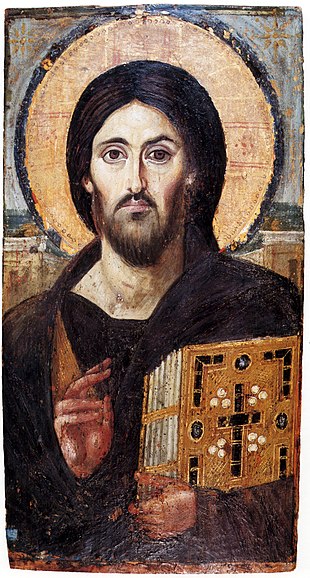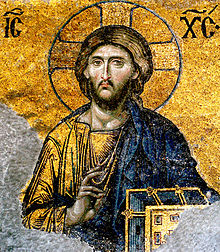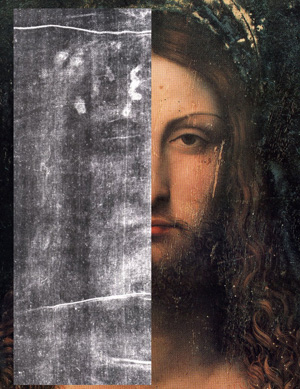
"Supper at Emmaus" is among the works being shown in "Rembrandt and the Face of Jesus.
Posted on 09/04/2011 8:42:12 AM PDT by bronxville
Rembrandt Paintings Changed How World Saw Christ By Lou Baldwin Source: Catholic News Service Published: Sunday, September 04, 2011
PHILADELPHIA (CNS)—Matthew, Mark, Luke and John told us all about what Jesus said and did, but not one of them mentioned what he looked like.
The vaguely European-featured Jesus with a brown beard and hair was pretty much the standard for most of history, at least until Rembrandt van Rijn, the greatest painter, draftsman and printmaker of the Dutch Golden Age, came along. In the mid-17th century he and students at his Amsterdam studio painted a series of at least eight heads of Christ which set the liturgical art world on its ear.
Rembrandt's studio was in a section of Amsterdam with a fairly large Jewish population, and it is believed the same young Jewish man was the model for all the portraits, which look remarkably like the olive-skinned and dark-haired men you would see strolling the Galilee shore today.
For the first time six of these paintings are brought together for an exhibit, "Rembrandt and the Face of Jesus," which was first exhibited at the Louvre in Paris and now at the Philadelphia Museum of Art (Aug. 3-Oct. 30) after which it will travel to the Detroit Institute of Art (Nov. 20-Feb. 12).
"'Rembrandt and the Face of Jesus' marks the first time that an exhibition including a substantial group of paintings by Rembrandt will be seen in Philadelphia," said Timothy Rub, director and CEO of the Philadelphia Museum of Art.
In his day Rembrandt was ridiculed for his innovative portrayal of the Savior. By long-standing tradition, the head of Jesus was taken from three sources—Veronica's veil, which according to tradition was imprinted with the image of Jesus after a woman wiped his face on the road to Golgotha; the Mandylion of Edessa, a similar icon venerated in the East; and the Lentulus letter, a written description of Christ purportedly written by the governor of Judea who preceded Pontius Pilate.
However, the Lentulus letter is generally dismissed as a 15th-century forgery, and neither Veronica's veil nor the Mandylion can be definitively traced to the first century.
In addition to the six heads of Jesus, the Philadelphia museum exhibit contains other Rembrandt works drawn from the great museums of America and Europe showing the artist's transition from the traditional to the innovative. Especially noteworthy are "Supper at Emmaus" and "Christ Preaching" (The Hundred Guilder Print), both from the Louvre.
Although a number of the paintings and prints in the exhibit are from the Philadelphia museum's collection, it includes only one "Head of Jesus." It is part of the vast John G. Johnson collection and was until recently in storage, because it was thought to be a more recent copy of Rembrandt's work. Typical of Rembrandt's period, it is painted on oak, and by close examination it was originally a smaller portrait pieced into a larger panel, with a background almost seamlessly painted to form a single panel.
When Lloyd DeWitt arrived at the museum a decade ago as associate curator of the Johnson collection, he was "extremely puzzled why someone would take such time on a copy and piece it together," said Jennifer Thompson, associate curator of European paintings and sculpture before 1900.
DeWitt consulted with Peter Kline, a wood biologist who has an international reputation for dating the panels works are painted upon. Through examination of the pattern of tree rings on the two panels, he was able to determine the main panel was from a tree harvested during Rembrandt's Amsterdam years, and the surrounding panel was even earlier, about 1610, which made it almost a certainty the picture was from Rembrandt's studio, not a later copy.
With the "Head of Jesus" authenticated, DeWitt conceived the notion of the exhibit with the Philadelphia museum's work as a starting point.
Although DeWitt himself recently moved on to the Art Gallery of Toronto in his native Canada, "he was the first to think about bringing all of the heads together for an exhibit," Thompson said.
http://www.americancatholic.org/news/report.aspx?id=3635

"Supper at Emmaus" is among the works being shown in "Rembrandt and the Face of Jesus.

Rembrandt and The Face of Jesus
For as long as I’ve been visiting the Philadelphia Museum of Art there has been a small painting called “Head of Christ” (image above, top) in the museum’s John G. Johnson collection of European Art (larger but somewhat oversaturated version here).
It is a small but strikingly beautiful painting, 14 x 12 inches (36 x 31 cm) showing a head and upper torso of a plainly garbed figure, clothing almost fading into the unadorned background, but focusing on a face, obviously that of a real person and not constructed from imagination, painted with exquisite skill.
For a long time the painting was not featured prominently, often tucked away in the corner of a gallery in a modest frame, presumably because its attribution was somewhat in question — at times to “Studio of Rembrandt”, later “Attributed to Rembrandt”. It’s only recently (and I’m not sure how recently) that the attribution has changed to “Rembrandt Harmensz. van Rijn”, making it the only painting directly attributed to Rembrandt in the museum’s collection.
Even when the attribution was in question, many visitors, myself included, just loved this painting. If it isn’t a Rembrandt, my thought was, it’s the next best thing, a work painted with such skill as to be considered for attribution to the master, and one with an extraordinary subtlety, economy and painterly finesse. The fact that it was often tucked away in an unassuming corner just made it seem that much more of a hidden gem.
Though I haven’t heard it confirmed, it’s my guess that it was the change in attribution that led the museum, in cooperation with the Musée du Louve in Paris and the Detroit Institute of Arts, to mount a new exhibition now on display here in Philadelphia titled Rembrandt and the Face of Jesus.
The exhibition is essentially built around a core display of this painting and six other similar bust-length portraits of comparable size and composition, some attributed directly to Rembrandt, others to the “Studio of”, but all shedding light on and enriching the experience of appreciating the others (images above, third, fourth and fifth down, with detail 6th down).
These have been borrowed from museums in Europe and the US, but the Philadelphia painting is the centerpiece, and the most striking of the group. I was also particularly impressed with this one (image above fourth and fifth down).
Expanding out from there, the exhibition is filled out with paintings, etchings and drawings, both by the master, his students and other artists who painted related portraits of Jesus, into an exhibition of 40 some works. It explores the changing interpretation by Rembrandt and others of the way Jesus was portrayed, something that had been bound by certain conventions, many of which Rembrandt broke by using live models and portraying Jesus as a real individual instead of an idealized icon.
The exhibit highlights this with some earlier examples by other artists but quickly moves into Rembrandt’s own groundbreaking interpretations. Though the exhibition is focused on this theme, and is far from a Rembrandt retrospective, it contains several striking works.
The Louvre contributes its wonderful painting of the the Supper at Emmaus (above, bottom two images). The tablecloth alone in this work struck me as a capsule defense of Rembrandt as one of history’s greatest painters. The reproduction from the Louvre feature on the exhibit, though not bad, still doesn’t to it justice.
http://canandanann.blogspot.com/2011/09/rembrandt-and-face-of-jesus.html
I found the above pictures here...
Um, no:

(earliest extent icon of Christ Pantocrator, sixth century at latest)
And one from Spain from the Romanesque period:

From Hagia Sopha:

And for good measure, one from Sicily:

All pre-Rembrandt.
Rembrandt’s Jesus has a shorter, broader face than the one on the Shroud of Turin. Just sayin’.
Interesting. A priest I once knew in Texas sent my husband searching museums and galleries in England and Scotland for a print of the Supper at Emmaus. We could not find it, and our friend is now deceased. Now, you say that it is at the Louvre. But the picture here meets Fr. Hall’s description of the painting that had moved him so much when he was a Seminarian.

Agree, Davids posting of pre-Rembrandt portrayals are a lot closer.
That’s a wonderful story. I only got to watch a minute but will finish when I get back from Mass.
That one looks like Rod Stewart with brown hair.
Indeed. Modern man just cannot conceive that the Christian civilization did not start sometime in 15c.
This story ties into Akiane's painting of Jesus.
"I just finished reading “Heaven is for Real.” I am thinking that the Akiane Prince of Peace is very similar to the man in the Turin Shroud. STURP and now the Shroud Science Group with all its scientific books and journals cannot begin to match the power of this story. Four-year-old Colton Burpo left the hospital operating room and went [to] heaven where he saw Jesus. Later, he confirmed that Jesus looked like the Akiane Jesus. The Akiane Jesus looks like the Turin Shroud."
Akiane’s Jesus, Heaven is for Real and the Man in the Turin Shroud
“Heaven is For Real” The little boy who went to Heaven was always being shown pictures of Christ. And he’d find something that wasn’t right. The painting you posted was the only one that struck the little boy as Christ, his eyes and his image.
Amazing thing is what a young girl, 12ish, painted this portrait.
There’s a crucifix in Lucca, I think, that’s at least this old and the image is similar. The eyes bulge a little, and the face is much closer than anything Rembrandt did.
Yes, that’s the tie-in. Didn’t she paint the portrait of Jesus at the age of eight?
Local legend has it that this crucifix was carved at the time of the Crucifixion by Nicodemus and that it arrived in Lucca miraculously in 782. (Source, also see Holy_Face of Lucca)
The St. Catherine monastery's Savior, however, is considered the oldest image that survived the Iconoclasm:
The oldest known surviving example of the icon of Christ Pantocrator was painted in encaustic on panel in the sixth or seventh century, and survived the period of destruction of images during the Iconoclastic disputes that twice racked the Eastern church, 726 to 787 and 814 to 842, by being preserved in the remote desert of the Sinai, in Saint Catherine's Monastery.[6] The gessoed panel, finely painted using a wax medium on a wooden panel, had been coarsely overpainted around the face and hands at some time around the thirteenth century. It was only when the overpainting was cleaned in 1962 that the ancient image was revealed to be a very high quality icon, probably produced in Constantinople

Yes, that’s it. Thank you.
Even more amazing if she was only eight as it is an excellent painting.
Disclaimer: Opinions posted on Free Republic are those of the individual posters and do not necessarily represent the opinion of Free Republic or its management. All materials posted herein are protected by copyright law and the exemption for fair use of copyrighted works.